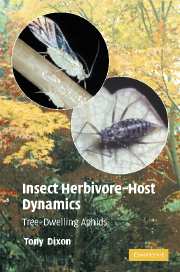Book contents
- Frontmatter
- Contents
- Preface
- 1 Introduction
- 2 Tree-dwelling aphids
- 3 Trees as a habitat: relations of aphids to trees
- 4 Trees as a habitat: relations of aphids to their natural enemies
- 5 Carrying capacity of trees
- 6 Aphid abundance
- 7 Population dynamics
- 8 Risky dispersal
- 9 Seasonal sex allocation
- 10 Aphids and tree fitness
- 11 Rarity, conservation and global warming
- Epilogue
- References
- Species index
- Subject index
10 - Aphids and tree fitness
Published online by Cambridge University Press: 08 August 2009
- Frontmatter
- Contents
- Preface
- 1 Introduction
- 2 Tree-dwelling aphids
- 3 Trees as a habitat: relations of aphids to trees
- 4 Trees as a habitat: relations of aphids to their natural enemies
- 5 Carrying capacity of trees
- 6 Aphid abundance
- 7 Population dynamics
- 8 Risky dispersal
- 9 Seasonal sex allocation
- 10 Aphids and tree fitness
- 11 Rarity, conservation and global warming
- Epilogue
- References
- Species index
- Subject index
Summary
Because they are small, and most do not damage the foliage of trees, aphids are not usually thought of as adversely affecting tree growth and reproduction. However, what they lack in size they make up for in abundance. The 116000 leaves of a 20m sycamore tree can be infested with as many as 2.25 million aphids, equivalent in mass to a large rabbit (Dixon, 1998), and the 58000 leaves of a 12m lime tree with 1.1 million aphids, equivalent to six great tits or four sparrows.
The studies considered here, involving approximately 150 tree years, revealed marked intraspecific differences between trees in the average level of infestation by aphids. However, in all cases these differences could be attributed mainly to differences in phenology between trees. That is, none of the trees appeared to show any antibiotic resistance to aphids. However, it must be stressed the identification of resistant trees was not a specific objective of this study.
AUTUMN LEAF COLOURS: SIGNAL OR SCREEN
Sycamore is a maple and in common with other species of Acer can have brightly coloured leaves in some autumns. This variation in sycamore is attributed in part to aphids, with high levels of infestation in spring resulting in leaves falling green, whereas low levels result in them turning yellow before leaf fall (Dixon, 1971a). Archetti (2000) and Hamilton and Brown (2001), however, suggest that the red and yellow leaf colours displayed in certain parts of the world signal a tree's ability to defend itself against insects.
- Type
- Chapter
- Information
- Insect Herbivore-Host DynamicsTree-Dwelling Aphids, pp. 147 - 161Publisher: Cambridge University PressPrint publication year: 2005



